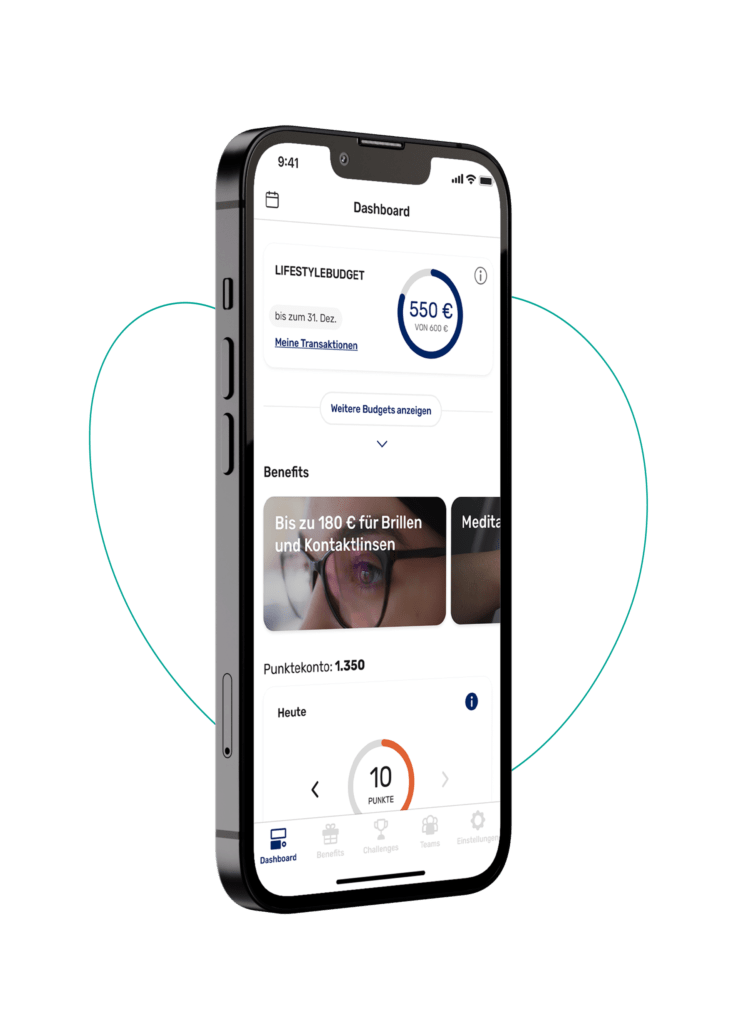
Meditationsapps und die Förderung von Krankenkassen Inhalte Wie können Meditationsapps unsere Psyche und Nerven stärken? Gesundheit ist unser höchstes Gut – doch zur Förderung dieser

Die gesundheitlichen Folgen der nun mehr als einjährig andauernden Covid-19-Pandemie sind erheblich. Während einerseits die direkten Erkrankungen durch das Coronavirus zu Buche schlagen sind auf der anderen Seite auch die – aufgrund der notwendigen Schutzmaßnahmen und damit verbundenen Restriktionen – indirekten gesundheitlichen Auswirkungen zu berücksichtigen. Die Gesundheit wurde hierzulande im aktuellen politischen Wertekanon als oberste Prämisse herausgestellt. Die verschiedenen Beeinflussungen der Gesundheit im Zuge der Pandemie sind komplex und rücken in zunehmenden Maßen auch die indirekten Folgen wie psychische Erkrankungen, Diabetes oder Rückenbeschwerden in den Fokus. Die Maßnahmen zur Infektionsvermeidung mit dem Coronavirus und den gängigen gesundheitsförderlichen Maßnahmen im Alltag wie Fitness sind in der Praxis oft konträr. Es zeigt sich ein Dilemma: Gesundheit gegen Gesundheit aufwiegen? Insofern kommt in Zeiten geschlossener Sportanlagen oder Homeoffice digitalen Anwendungen offenbar eine besondere Rolle zu. Der Beitrag beleuchtet dabei insbesondere den Aspekt von körperlicher Aktivität, welche durch niederschwellige Gesundheits-Apps vermittelt kann.
Jeder weiß es: Körperliche Aktivität stiftet einen bedeutsamen gesundheitlichen Nutzen, schließlich hat uns die Evolution auf Bewegung programmiert. Bewegung ist elementarer Baustein für ein gesundes Leben: Angefangen vom allgemeinen Wohlbefinden über die körperliche bis hin zu psychischer und sozialer Gesundheit. Körperlicher Aktivität wird somit in Hinblick auf die Themen Prävention und Therapie von Erkrankungen eine wachsende Bedeutung beigemessen. Die Botschaft der weltweiten Gesundheitsinitiative ‚Exercise is Medicine‘ ist in diesem Zusammenhang selbstredend.
Klare Empfehlungen für ein Mindestmaß an Bewegung zur Gesunderhaltung – wie den wöchentlichen 150 Minuten moderater aerober Aktivität – werden von Fachorganisationen wie der WHO propagiert (World Health Organization, 2020).
Die Realität hierzulande verzeichnet hingegen ein Bewegungsverhalten, dass die überwiegende Zahl der Menschen diese Minimalvorgaben verfehlt (World Health Organization, et al., 2016; Froböse, et al., 2018). Folglich steigen die Zahlen insbesondere bei den sogenannten Volkskrankheiten. Zu den wesentlichen Ursachen gelten unbestritten die beiden Risikofaktoren einer ungesunden Lebensweise sowie Bewegungsmangel. Betroffene leiden allmählich unter den Auswirkungen der Krankheiten und der damit verbundenen Verminderung an Lebensqualität und erfahren finanzielle Nachteile durch eine eingeschränkte Arbeitsfähigkeit. Dem Gesundheitssystem entstehen dabei erhebliche Mehrkosten (Ding, et al., 2017).
Dabei zeigen Studien, welches Wundermittel Sport darstellen kann: Das Risiko für die Entwicklung von 13 Krebsarten kann um bis zu 42% verringert werden (Moore, et al., 2016). Aktives Spazierengehen im Umfang von 2,5 Stunden pro Woche reduziert bei Gesunden das Diabetesrisiko um 30% (Jeon, et al., 2007). Der Gegenspieler Sitzen hingegen wird nicht zu Unrecht als das „neue Rauchen“ an den Pranger gestellt. Wer die Achtstunden-Marke beim Sitzen am Tag regelmäßig knackt, hat ein um 80% erhöhtes Sterberisiko (Stamatakis, et al., 2019). Und ein gutes Fitnesslevel geht mit einem bis zu 88% geringerem Demenzrisiko einher (Hörder, et al., 2018). Chronischem Stress kann ebenfalls mit Bewegung, insbesondere moderatem Ausdauersport entgegen- und vorgebeugt werden (Gerber, et al., 2016). Aber nicht nur für die generelle Gesunderhaltung des Körpers sind Sport & Bewegung unabdinglich, auch im Hinblick der Pandemie ist dies ein wesentlicher Schutzfaktor für die Leistungsfähigkeit unseres Immunsystems. So zählt körperliche Inaktivität als indirekt wirkender Risikofaktor für einen schweren Verlauf einer COVID-19-Erkrankung.
Fachgesellschaften wie die Deutsche Gesellschaft für Sportmedizin und Prävention (DGSP) weisen mahnend darauf hin, dass auch die aktuelle körperliche Inaktivität weitreichende Folgen für die Gesundheit wie beispielsweise Herz-Kreislauf-Erkrankungen, Bluthochdruck und Typ-II-Diabetes haben kann (Deutsche Zeitschrift für Sportmedizin, 2020).

Mit dem Bus zur Arbeit, Bürojob, abends was beim Lieferservice bestellen – die moderne Welt bringt uns jede Menge elektrische Mobilität zulasten körperlicher Aktivität und somit schnell in die Komfortzone. Während der Durchschnittswert ohnehin schon deutlich unter den vielzitierten 10.000 Schritten am Tag eher bei 5.000 liegt (Althoff, et al., 2017), torpediert Corona nun bei zahlreichen Menschen das Streben nach mehr Aktivität vollends.
Wer in Zeiten der Pandemie nach einem Tag im Homeoffice mit schlechtem Gewissen abends auf seinen Fitnesstracker schaute, sah mit Entsetzen nicht selten eine dreistellige Schrittzahl. Der Grund: Beschränkungen für den öffentlichen Raum haben die gewohnten Möglichkeiten für körperliche Aktivität drastisch verändert. Zum Beispiel fanden sämtliche Präsenzsportkurse nicht statt, Fitness-Studios und andere Sportstätten waren geschlossen. Auch Alltagsaktivitäten standen unter dem Einfluss, sodass Fuß- oder Radwege zur Arbeit, zur Kita oder Schule wegen Homeoffice/-schooling entfielen.
Zahlreiche nationale und internationale Studien untersuchten die Veränderungen von körperlicher Aktivität vor allem für die Phasen der Lockdowns. Die zur Eindämmung des Virus eingesetzten Maßnahmen bewirkten dabei einen signifikanten Einfluss auf das Aktivitätsverhalten der Menschen. Weltweit ging die Zahl der täglichen Schritte zurück nachdem COVID-19 zur Pandemie erklärt wurde, wobei regionale Unterschiede hier aufgrund verschiedener regulatorischer Maßnahmen sichtbar werden (Tison, et al., 2020).
Im Rahmen des laufenden Projektes „SPOVID“ beleuchten Forscher der FAU Erlangen-Würzburg die Veränderungen der körperlichen Aktivität in der deutschen Bevölkerung im Verlauf der Corona Pandemie. Vorliegende Ergebnisse aus dem ersten Lockdown verdeutlichen einen Rückgang der Freizeitsport-Aktivitäten und der Bewegung. Die Verteilung zeigte hierbei, dass etwa ein Drittel weniger aktiv war, 27% das Aktivitätsniveau in etwa konstant hielten und nur 6% der Menschen dieses steigern konnten (Mutz, et al., 2020). In dieses Bild fügen sich passend die Analysen des Fitnessarmband-Herstellers Fitbit ein: 11% weniger Schritte wurden von den Usern im März 2020 absolviert verglichen zu März 2019 (Fitbit, 2020).
Eine differenzierte Betrachtung einzelner Merkmale wie dem Alter erscheinen dabei sinnvoll, um auch optimale, zielgruppenspezifische Schlussfolgerungen ziehen zu können. In diesem Kontext untersuchte der kürzlich veröffentlichte Deutsche Alterssurvey im Rahmen einer repräsentativen Umfrage von Menschen in der zweiten Lebenshälfte die körperliche Aktivität: Dabei gaben 30,9% der 46- bis 60-Jährigen an, dass sich ihre sportliche Aktivität in der Pandemie verringert hat (Nowossadeck, et al., 2021).
Vor allem die Fitnessbranche bemühte sich um eine Debatte über gesundheitliche Langzeitfolgen durch Schließung von Sportanlagen und des damit einhergehenden Verbotes von Sport und Gesundheitstraining. Zwar wurde punktuell von öffentlicher Seite versucht – wie zum Beispiel mittels temporärer Sonderregelungen zur Durchführung von zertifizierten Präventionspräsenzkursen (§20 SGB V) auf digitalem Wege – Anbietern und Teilnehmern Alternativen zu ermöglichen. Dennoch ist davon auszugehen, dass derartige Maßnahmen keineswegs ausreichen, um das verringerte Aktivitätsverhalten zu kompensieren.
Im Zusammenhang mit den Corona-bedingten Restriktionen für den Sport-/Fitnessbereich äußerte der Vorstand der IKK Südwest und Präventionsexperte Prof. Dr. Loth zuletzt die Befürchtung eines weiteren Anstieges zahlreicher Volkskrankheiten, die wiederum eine Corona-Infektion begünstigen können und verweist dabei auf die bundesweit täglich mehr als 1.500 Neuerkrankungen an Diabetes Typ 2 (Loth, J). Übergewicht/ Adipositas und Bewegungsmangel zählen zu den wesentlichen Risikofaktoren für Diabetes Typ 2, weswegen Fachleute wie Loth beunruhigt sind: Seit Beginn der Pandemie im März 2020 steigt die Tendenz zu Übergewicht und Bewegungsmangel in der Bevölkerung. Gerade bei der Zuckerkrankheit äußert sich das Problem, dass nach einer manifesten Erkrankung eine Genesung kaum zu erwarten ist. Das wiederum bedeutet für die Betroffenen multiple Komplikationen und damit verbundene Einschränkungen in der Lebensqualität. Diabetiker haben obendrein ein erhöhtes Risiko bei Infektionen mit dem Coronavirus einen schweren Krankheitsverlauf zu erleiden. Insgesamt stellt dies eine massive Erhöhung an Gesundheitsausgaben für Krankenkassen und Solidargemeinschaft dar.
Die DAK-Krankenstands-Analyse (DAK, 2021) für das Corona-Jahr 2020 stellt die massiven Veränderungen des Krankheitsgeschehen in der Arbeitswelt während der Pandemie heraus. Die Ausfalltage wegen muskuloskelettalen Erkrankungen, insbesondere den Rückenschmerzen, stiegen verglichen mit dem Vorjahr um sieben Prozent. Psychische Erkrankungen erreichten zudem einen neuen Höchststand. Krankschreibungen dauerten durchschnittlich 14,5 Prozent länger als in 2019. Als wesentliche Ursache ist vor allem das durch den Lockdown bedingte bewegungsarme Homeoffice zu sehen. Ausreichend Bewegung ist aber gerade in diesen Zeiten von unschätzbarer Bedeutung, da sie der Aufrechterhaltung der physischen sowie mentalen Gesundheit dient.
Nicht verwunderlich scheint, dass ebenfalls die seelische Befindlichkeit der deutschen Bevölkerung schwer auf das Gemüt schlug. So lebt laut einer repräsentativen Bevölkerungsumfrage der pronova BKK (n=1.000) aus dem März diesen Jahres über die Hälfte der Menschen hierzulande in Angst und Sorge. Dabei geben 29% an das „Sporttreiben“ als Bewältigungsstrategie bzw. als Stress-Entlastung zu nutzen (pronova BKK, 2021).
Für das Jahr 2020, also während der Gesundheitskrise COVID-19 war weltweit ein deutlich gestiegenes Interesse an Gesundheits-Apps zu verzeichnen (Statista, 2021). Wie eingangs beschrieben, ist der Bedarf an Bewegungsangeboten im digitalen Format derzeit erheblich, da neben der outdoor-basierten Individualfitness sonst keine nennenswerten weiteren Alternativen für sportliche Aktivität vorliegen. Die alljährlichen globalen Fitnesstrends 2021 des renommierten American College of Sportsmedicine unterstreichen die Einflussnahme der COVID-19-Pandemie (Thompson, 2021): Auf Platz 1 lag das Online-Training direkt gefolgt von Wearable Technology (Fitnesstracker, Smartwatches, usw.). Virtuelle Sportkurse sind für viele Nutzende mittlerweile nicht mehr wegzudenken.
Während die großen Veränderungen in der Gesundheits-Fitnessbranche seit Jahren erstmals einen herben Rückgang der Mitgliederzahlen bedeuteten (Statista, 2021), gaben sie diesem Bereich in puncto Innovation und Digitalisierung einen enormen Schub. Es zeigte sich eine insgesamt hohe Nutzungsquote dieser neuen Möglichkeiten. Vor- und Nachteile gilt es grundsätzlich immer zu diskutieren und abzuwägen. So lässt sich beispielsweise eine individuelle, professionelle Korrektur bei der Übungsausführung durch Coaches nicht optimal ohne physische Präsenz gewährleisten. Dafür gewinnen die Teilnehmer ein hohes Maß an räumlicher und zeitlicher Flexibilität. Unter dem Strich galt es aber überhaupt zeitgemäße Lösungen kurzfristig im Schatten der Pandemie, aber auch langfristig anzubieten, welche Entwicklungen wie der modernen Arbeitswelt gerecht werden.
Es gibt immer mehr Menschen, die sich auch von den Angeboten niedrigschwelliger Gesundheits-Apps mit Lifestyle- & Fitnesscharakter angesprochen fühlen. Denn gerade mobile Anwendungen (Apps) sind es, die auf die regelmäßige, meist tägliche Einübung eines umschriebenen Gesundheitsverhaltens abzielen und uns dadurch helfen, unsere (Ergebnis- oder Verhaltens-) Ziele auch zu erreichen. Stärker als digitale Kursformate noch, fokussieren Apps die nachhaltige Verankerung eines Gesundheitsverhaltens im Lebensalltag. Studien liefern ermutigende Belege für die positiven Auswirkungen der Verwendung von Fitness-Tracking-Apps zur Förderung des Gesundheitsverhaltens (Gabbiadini, et al., 2019).
Die steigende Wertigkeit von Apps zur Prävention spiegelt sich aber auch in den gesetzlichen Vorgaben wider. So wurde der Leitfaden Prävention nach § 20 SGB V des GKV Spitzenverbandes gerade erst im Dezember 2020 um das neue und nun eigenständige Kapitel 7 „Digitale Prävention und Gesundheitsförderung“ ergänzt. Die bis dato gemeinsame Regelung aller Maßnahmen zur individuellen verhaltensbezogenen Prävention (analog & digital) ist damit überholt. Die Änderung sieht nun auch eine stärkere qualitative Ausrichtung vor, sodass auf Basis eines standardisierten Studiendesigns, Nachweise für den gesundheitlichen Nutzen der Angebote erbracht werden müssen.
In diesem Zusammenhang werden die Verwendung von standardisierten Techniken der Verhaltensänderungen (engl. Behavior Change Techniques) sowie von Gamification als vielversprechende Ansätze für gesundheitsrelevante Verhaltensänderungen erachtet. Gamification meint „die Übertragung von spieltypischen Elementen und Vorgängen in spielfremde Zusammenhänge mit dem Ziel der Verhaltensänderung und Motivationssteigerung bei Anwenderinnen und Anwendern“ (Bendel). Wissenschaftliche Studien belegen positive Effekte für Motivation, Leistung und langfristiges Engagement. Tolks et al. sieht insbesondere dort Potenzial für den Einsatz von Gamification, wo die grundsätzliche Motivation der Nutzenden eher niedrig ist. Aktivitäten, welche ohne App den Nutzenden mitunter als eintönig und langweilig erscheinen (z. B. mehr Alltagsbewegung durch tägliche Schritte), können durch Gamification mehr Bedeutung zugesprochen werden. Täglich eine halbe Stunde am Tag zügig zu spazieren, klingt gerade in Zeiten der Pandemie machbar, da mit dem Homeoffice auf den ersten Blick mehr zeitlicher Spielraum für Alltagsbewegung gewonnen wird. In der Praxis gestaltet sich die Verankerung in feste Tagesstrukturen aber gerade aus motivationaler Sicht schwierig. Gesundheits-Apps und im Speziellen auch deren Challenge-Feature erscheinen umso sinnvoller. Das englische Wort „Challenges“ hat sich in unserem Sprachgebrauch bereits fest verankert. Eine schlichte Google-Recherche aus „Challenges + Corona“ liefert knapp eine Milliarde Treffer!! Die Corona-Pandemie ist zweifelsohne eine große Herausforderung. Doch gerade in diesem Fall beinhaltet der Begriff Challenge eben auch ein ermutigendes, positives, motivierendes Momentum, im Sinne von Antrieb zu Veränderung, packen wir es an oder dem Volksmund nach: Man wächst an der Herausforderung.
Auch im Setting der Betrieblichen Gesundheitsförderung ist die Digitalisierung angekommen und das nicht erst seit Corona, aber im Zuge der Pandemie haben digitale Angebote nochmals einen deutlichen Schub erfahren. Die in Deutschland führende Angebotsplattform für BGF-Maßnahmen – Machtfit – verweist auf einen drastischen Anstieg ihrer digitalen Angebote von 6.500 (2019) auf 23.000 (2020) Nutzende. Unternehmen stehen vor der großen Herausforderung, Ihre Mitarbeiter gesundheitlich zu fördern sowie die Motivation trotz räumlicher Distanz im Remote-Status hochzuhalten. Wenn die aktive Pause im Büro oder das Firmen-Laufevent keine Option im Lockdown sind, können teaminterne Schritte-Challenges via App, welche beispielsweise auch Wettbewerbe zwischen den Abteilungen ermöglichen, als wahre Motivationstreiber wirken.
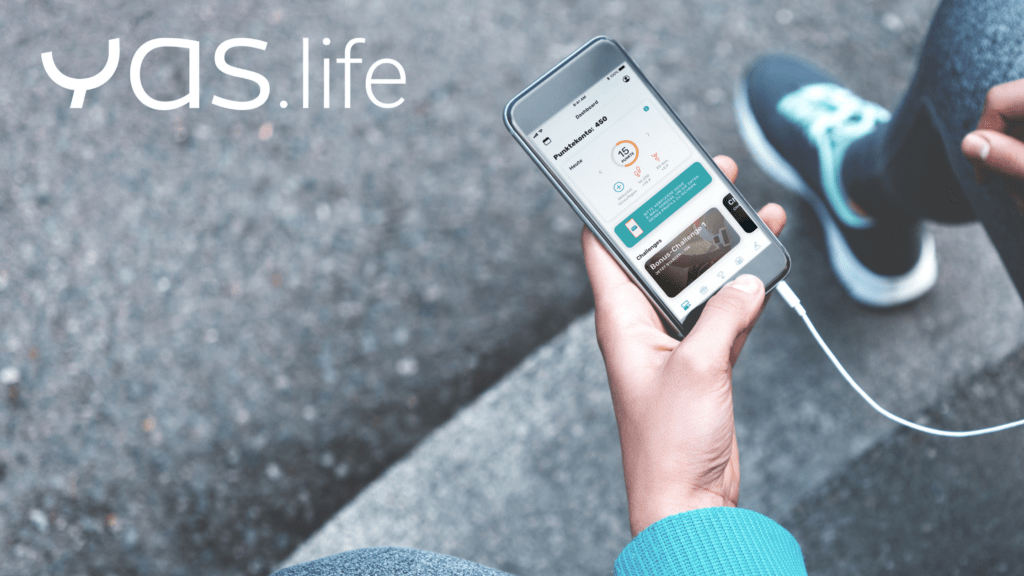
Unter dem Namen YAS.life entwickelt die MAGNUM EST Digital Health GmbH digitale Anwendungen als White-Label-Lösungen für Krankenkassen, Versicherungen und Unternehmen im Bereich Gesundheitsmanagement. Körperliche Aktivität und Fleiß sollen sich nicht nur physisch lohnen: YAS.life bietet eine eigene innovative Fitness-App als Bonusprogramm. Mit deren Hilfe können Nutzende diverse Prämien für körperliche Aktivität, gesunde Ernährung, Achtsamkeit oder präventive Vorsorge erhalten. Ziel des Unternehmens ist es, so langfristig mehr Menschen für einen gesunden Lebensstil zu motivieren und mit den Partnern langfristig attraktive Benefits für körperlich aktive Menschen zu bieten. Zukünftig will man so gemeinsam noch mehr Synergien schaffen und über die App Kunden für einen aktiven Lebensstil begeistern und gleichzeitig belohnen.
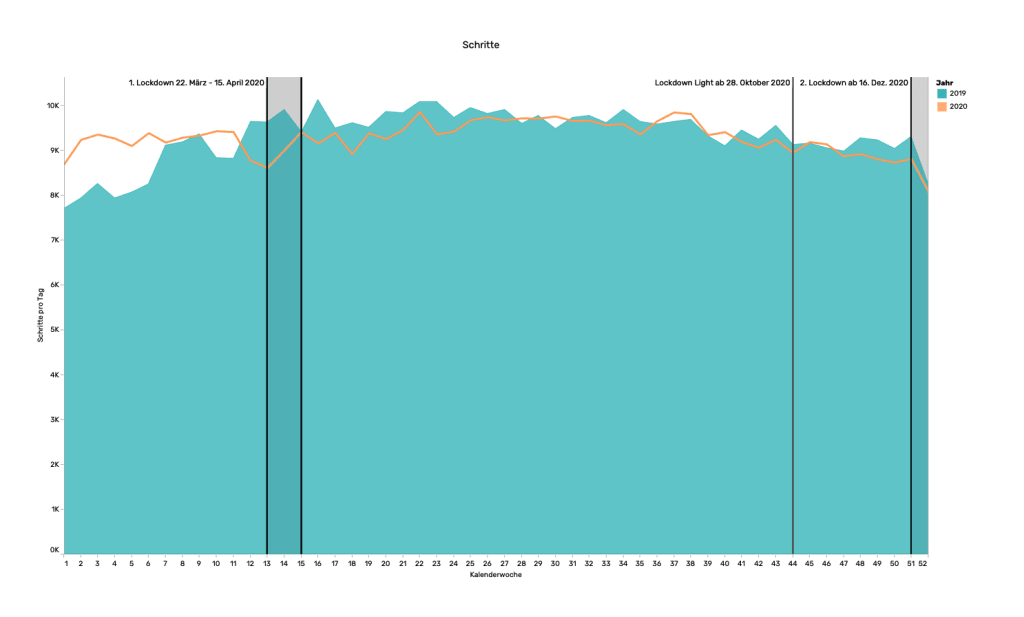
Abb.1 Gegenüberstellung der Schrittezahlen im Verlauf der Jahre 2019 und 2020 bei Nutzenden der YAS-App
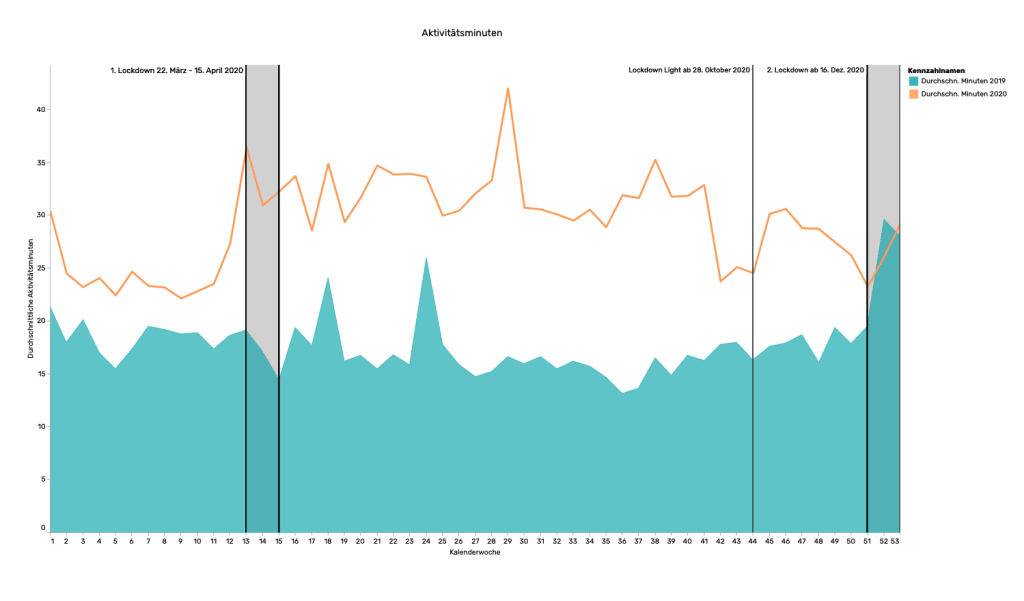
Abb. 2: Gegenüberstellung der Aktivitätsminuten im Verlauf der Jahre 2019 und 2020 bei Nutzenden der YAS-App
In welchem Maße können digitale Begleiter einen gesundheitlichen Nutzen stiften? Wie gut die YAS-App funktioniert und Ihrer motivierenden Mission nachkommt, zeigen die Abbildungen 1 und 2. Dargestellt ist zunächst das Bewegungsverhalten in Form von täglichen Schritten vor (2019) und während der COVID-19-Pandemie. Entgegen des allgemeinen Trends – das Absinkens von körperlicher Aktivität während der Coronakrise – zeigt sich hierbei keine bedeutsame Veränderung. YAS-User sammeln gleich viele Schritte wie vor der Pandemie (ØΔ Schritte2019/2020 = -0,12%)
Abbildung 2 verdeutlicht die Dauer trackbarer körperlicher Aktivität wie Radfahren, Laufen oder Yoga. Hierbei kam es sogar zu einem deutlichen Anstieg der körperlichen Aktivitäten von etwa 70%. Trotz zeitweiser Kontaktbeschränkungen und Bewegungseinschränkungen wurde offensichtlich auf neue bzw. alternative Bewegungsformen in hohem Maße zurückgegriffen.
In der Konsequenz haben es die Nutzenden der YAS-App, die mit zahlreichen Gamification-Elementen wie Statistik-Feature, Health-Goal-Setting oder Lernquizzen versehen ist, in der für Bewegungsmangel anfälligen Phase des Corona-Jahres 2020 geschafft, Ihre Fitnessaktivitäten langfristig zu steigern und damit einen wesentlichen Risikofaktor für chronische Erkrankungen zu reduzieren.
Wir alle sehnen uns durch lange, restriktive Phasen des Lockdowns mit seinen zahlreichen virtuellen Aktivitäten vor allem nach dem „zusammen & raus“. Wenngleich die Corona-Krise hoffentlich durch umfassende Impfmaßnahmen alsbald besiegt sein wird, werden viele Entwicklungen wie Homeoffice und damit einhergehend auch entfallende Wege zur Arbeit ein Dauerthema bleiben. Die Leute lechzen zwar nach dem „echten“ Besuch im Yogastudio. Das Rad der Digitalisierung wird sich aber nicht zurückdrehen und deshalb werden Onlinekurse, individuelle Coachings via Zoom & Skype keineswegs verschwinden, sondern das Angebot erweitern. Insbesondere mobile Anwendungen in Form präventiver Fitness-/ Wellness/ Lifestyle-Apps werden post Corona ein sinnvoller Baustein für die individuelle Gesundheitsförderung bleiben und in ihrer Bedeutung weiter steigen. Die Frage danach, wie viele Schritte bin ich heute schon gegangen, ist für viele von uns ja zur Gewohnheit geworden. Entgegen des Corona-Blues und seiner Online-Müdigkeit gilt es hervorzuheben, dass das Medium App mit seiner niederschwelligen Motivation zwar der digitalen Welt zuzurechnen ist in Verbindung mit der eigentlichen körperlichen Aktivität – dem TUN – aber zumeist analog, geräuscharm nebenbei und im Freien geschieht.
Im Bereich der Betrieblichen Gesundheitsförderung werden zukünftige Lösungen länger schon im Nebeneinander bzw. in der Verknüpfung analoger und digitaler Lösungen von Experten gesehen (Baxheinrich, et al., 2018). Digitale Angebote erhöhen die Reichweite und Verfügbarkeit von Maßnahmen. Sie zudem sind ressourcenschonend sowie zeitlich und räumlich flexibel. Dezentralität und unterschiedlichste Arbeitszeitmodelle sind somit kein Problem mehr. Analoge Angebote profitieren ebenfalls, wenn sie mit digitalen Angeboten verknüpft werden und dadurch z. B. ein besserer Praxistransfer des Erlernten unterstützt wird.
Auch die Prävention und Gesundheitsförderung in Lebenswelten nach § 20a SGB V (Setting-Ansatz) unterliegt einem fundamentalen digitalen Wandel. Auf den ersten Blick dabei scheint der Einsatz digitaler Gesundheitstechnologien sich auf Individualebene zu fokussieren und somit tendenziell als ein Puzzleteil komplexer öffentlicher Gesundheitskampagnen wie den WHO-Healthy Cities zu beschränken. Es verändern sich aber durch digitale Entwicklungen die Lebenswelten selbst (z. B. digitale Studiengänge, eSport-Angebote, onlinebasierte Nachbarschaftsforen). Hier fehlt es aktuell noch an einer praktischen, politischen und auch wissenschaftlichen Auseinandersetzung mit der Bedeutung der Digitalisierung für die Gesundheitsförderung und digitalisierten Lebenswelten.
Nicht alleinig aufgrund Corona, aber verstärkt durch die Pandemie zeigen sich für Versicherungen, Krankenkassen und Unternehmen Potenziale im Bereich der digitalen Gesundheitsförderung. Niederschwellige Health-Apps bieten wie beschrieben einen bedeutsamen Beitrag für die Reduktion des Risikofaktors Bewegungsmangel und damit verbundener chronischer Erkrankungen und deren Folgekosten.
About the authors
Dr. Magnus Kobel ist seit mehr als 15 Jahren in der Versicherungsbranche tätig. Nach Stationen bei der Allianz war er viele Jahre als strategischer Unternehmensberater – zuletzt bei Deloitte Consulting – mit dem Schwerpunkt Krankenversicherungen tätig. Im Jahr 2016 gründete Magnus Kobel die MAGNUM EST Digital Health GmbH und entwickelt seitdem mit YAS.life digitale Anwendungen für Krankenkassen, Versicherungen und Unternehmen im Bereich Gesundheitsmanagement sowie Prävention.
Matthias Jaworski ist Sportwissenschaftler und Healthmanager bei YAS.life. Für den Sportwissenschaftler und ehemaligen Leistungssportler dreht sich alles um die drei großen Themenblöcke Ausdauersport, Gesundheit und Prävention. Das Hobby auf dem sportlichen Höhepunkt seiner Leichtathletik-Karriere lieber zum Beruf gemacht, überträgt er seine Expertise als Healthmanager heute in die digitale Welt von YAS.life und ist parallel als Ausdauerexperte- und Coach aktiv.
Althoff, T, Sosič, R und Hicks, J. 2017. Large-scale physical activity data reveal worldwide activity inequality. Nature. 2017, Bd. 547, S. 336–339.
American College of Sports Medicine. https://www.exerciseismedicine.org/. [Online]
Baxheinrich, A und Henssler, O. 2018. Auf dem Weg zum BGM 4.0: Verknüpfung der analogen und digitalen Welt – Chancen und Grenzen für das Betriebliche Gesundheitsmanagement. [Buchverf.] D Matusiewicz und L Kaiser. [Hrsg.] Essen, Deutschland FOM Hochschule für Oekonomie & Management. Digitales Betriebliches Gesundheitsmanagement – Theorie und Praxis. 2018, S. 301-321.
Bendel, O. https://wirtschaftslexikon.gabler.de/definition/gamification-53874. Gamification – Definition.
DAK. 2021. DAK Krankenstands-Analyse 2020. 2021.
Deutsche Zeitschrift für Sportmedizin. 2020. https://www.zeitschrift-sportmedizin.de/dzsm-mitteilungen/dgsp-warnt-vor-inaktivitaet-waehrend-der-coronavirus-pandemie/. [Online] 2020.
Ding, D, et al. 2017. The economic burden of physical inactivity: a systematic review and critical appraisal. British Journal of Sports Medicine. 2017, Vol. 51 (19), S. 1392-1409.
Fitbit. 2020. The Impact Of Coronavirus On Global Activity. 2020.
Froböse, I, Biallas, B und Wallmann-Sperlich, B. 2018. Der DKV-Report 2018 – Wie gesund lebt Deutschland? s.l. : DKV Deutsche Krankenversicherung, 2018.
Gabbiadini, A und Greitemeyer , T. 2019. Fitness mobile apps positively affect attitudes, perceived behavioral control and physical activities. The Journal of Sports Medicine and Physical Fitness. 2019, 59(3), S. 407-414.
Gerber, M, et al. 2016. Fitness Moderates the Relationship between Stress and Cardiovascular Risk Factors. Medicine and Science in Sports and Exercise. 2016, 48(11), S. 2075-2081.
GKV-Spitzenverband. 2020. Leitfaden Prävention – Handlungsfelder und Kriterien nach § 20 Abs. 2 SGB V. 2020.
Hörder, H, et al. 2018. Midlife cardiovascular fitness and dementia – A 44-year longitudinal population study in women. Neurology. 2018, 90(15).
Jeon, C, et al. 2007. Physical activity of moderate intensity and risk of type 2 diabetes: a systematic review. Diabetes Care. 2007, 30(3), S. 744-52.
Loth, J. „Hypothek für die Zukunft“ – Interview Cityradio Saarland vom 22.01.2021.
Machtfit. 2021. Gesundheitsbranche 2.0 – Trends für 2021. 2021.
Moore, S, Lee, I und Weiderpass, E. 2016. Association of Leisure-Time Physical Activity With Risk of 26 Types of Cancer in 1.44 Million Adults. JAMA Internal Medicine. 2016, 176(6), S. 816-825.
Mutz, M und Gerke, M. 2020. Sport and exercise in times of self-quarantine: How Germans changed their behaviour at the beginning of the Covid-19 pandemic. International Review for the Sociology of Sport. 2020.
Nowossadeck, S, Wettstein, M und Cengia, A. 2021. Körperliche Aktivität in der Corona Pandemie: Veränderung der Häufigkeit von Sport und Spazierengehen bei Menschen in der zweiten Lebenshälfte. DZA aktuell – Deutscher Alterssurvey. 2021, 3/21.
pronova BKK. 2021. Die Süchte der Deutschen. 2021.
Stamatakis, E, et al. 2019. Sitting Time, Physical Activity, and Risk of Mortality in Adults. Journal of the American College of Cardiology. 2019, 73(16), S. 2062-2072.
Statista. 2021. Wegen Corona: Fitnessstudios verlieren Mitglieder. Mitglieder von Fitnessclubs in Deutschland (in Mio.). 2021.
Statista. 2021b. Zuwachs bei heruntergeladenen Gesundheit-Apps im Zuge der COVID-19-Pandemie nach Ländern im Jahr 2020. 2021.
Thompson, W. 2021. Worldwide Survey of Fitness Trends for 2021. ACSM’s Health & Fitness Journal. 2021, 25(1), S. 10-19.
Tison, G, et al. 2020. Worldwide Effect of COVID-19 on Physical Activity: A Descriptive Study. Annals of Internal Medicine. 2020, 173(9).
Tolks, D, et al. 2020. Spielerische Ansätze in Prävention und Gesundheitsförderung – Serious Games und Gamification. Bundesgesundheitsblatt – Gesundheitsforschung – Gesundheitsschutz. 2020, 63, S. 698-707.
World Health Organization und European Commission. 2016. Germany Physical Activity Factsheet. 2016.
World Health Organization. 2020. WHO guidelines on physical activity and sedentary behaviour. 2020.

Meditationsapps und die Förderung von Krankenkassen Inhalte Wie können Meditationsapps unsere Psyche und Nerven stärken? Gesundheit ist unser höchstes Gut – doch zur Förderung dieser
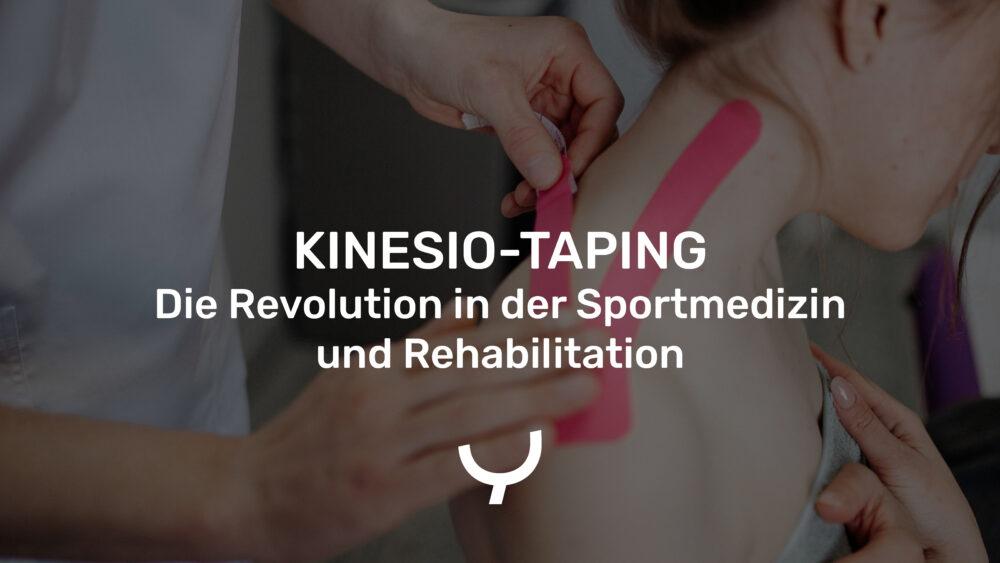
Kinesio-Taping – Die Revolution in der Sportmedizin und Rehabilitation Inhalte In den letzten Jahren hat sich die Welt der Sportmedizin und Rehabilitation rasant weiterentwickelt. Eine

LASIK OP: Ein klarer Blick auf die Zukunft Inhalte Die moderne Medizin hat in den letzten Jahrzehnten erstaunliche Fortschritte gemacht, insbesondere im Bereich der Augenheilkunde.
